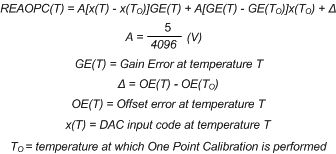ZHCSCA9A March 2014 – April 2015 LMP92066
PRODUCTION DATA.
- 1 特性
- 2 应用范围
- 3 说明
- 4 简化电路原理图
- 5 修订历史记录
- 6 Pin Configuration and Functions
- 7 Specifications
-
8 Detailed Description
- 8.1 Overview
- 8.2 Functional Block Diagram
- 8.3 Features Description
- 8.4 Device Functional Modes
- 8.5
Programming
- 8.5.1 Temperature Sensor Output Data Access Registers
- 8.5.2 DAC Input Data Registers
- 8.5.3 Temperature Sensor Status Register
- 8.5.4 Override Control Register
- 8.5.5 Override Data Registers
- 8.5.6 EEPROM Control Register
- 8.5.7 Software RESET Register
- 8.5.8 Access Control Register
- 8.5.9 Block I2C Access Control Register
- 8.5.10 I2C Address LOCK Register
- 8.5.11 Output Drive Supply Status Register
- 8.5.12 Device Version Register
- 8.5.13 EEPROM Burn Counter
- 8.5.14 LUT Coefficient Registers
- 8.5.15 LUT Control Registers
- 8.5.16 Notepad Registers
- 8.6 Register Map
- 9 Application and Implementation
- 10Power Supply Recommendations
- 11Layout
- 12器件和文档支持
- 13机械、封装和可订购信息
12 器件和文档支持
12.1 器件支持
12.1.1 器件命名规则
-
REAOPC
一点校准后的残余误差是由于组成信号处理块的错误在模拟信号路径中得到的误差:其中的组成信号处理块有 DAC,缓冲放大器,内部基准。 REAOPC 主要由偏移和增益温度漂移决定,这是因为初始误差的绝大部分在一点校准的过程中被消除。 DAC 线性误差 (INL) 所造成的误差可被忽略,这是因为这个误差在数量上微不足道。 通过以下公式可预计 REAOPC:

-
一点校准
一点校准是 LMP92066 的输出在系统中被调整,以实现所需响应的过程,此时温度为 T0。 通常情况下,这个过程涉及总体系统输出变量的测量;例如,PA 的 ID,在 LUT 中修改 BASE 值,以实现所需的 PA 偏置电流。
12.2 商标
PowerPAD is a trademark of Texas Instruments Incorporated.
All other trademarks are the property of their respective owners.
12.3 静电放电警告

这些装置包含有限的内置 ESD 保护。 存储或装卸时,应将导线一起截短或将装置放置于导电泡棉中,以防止 MOS 门极遭受静电损伤。